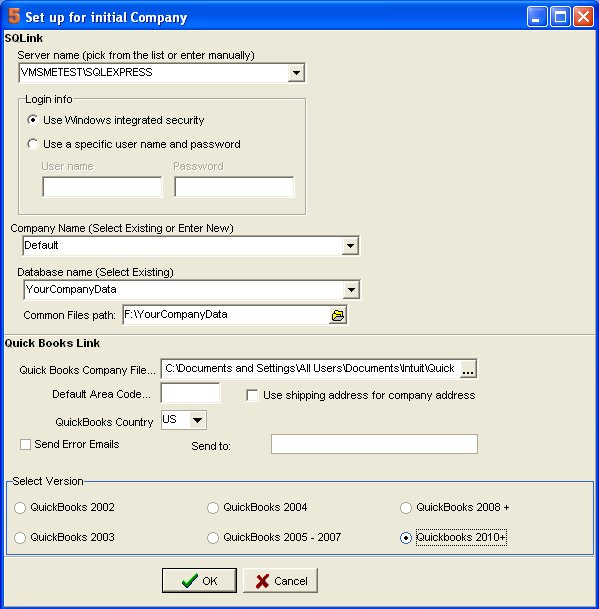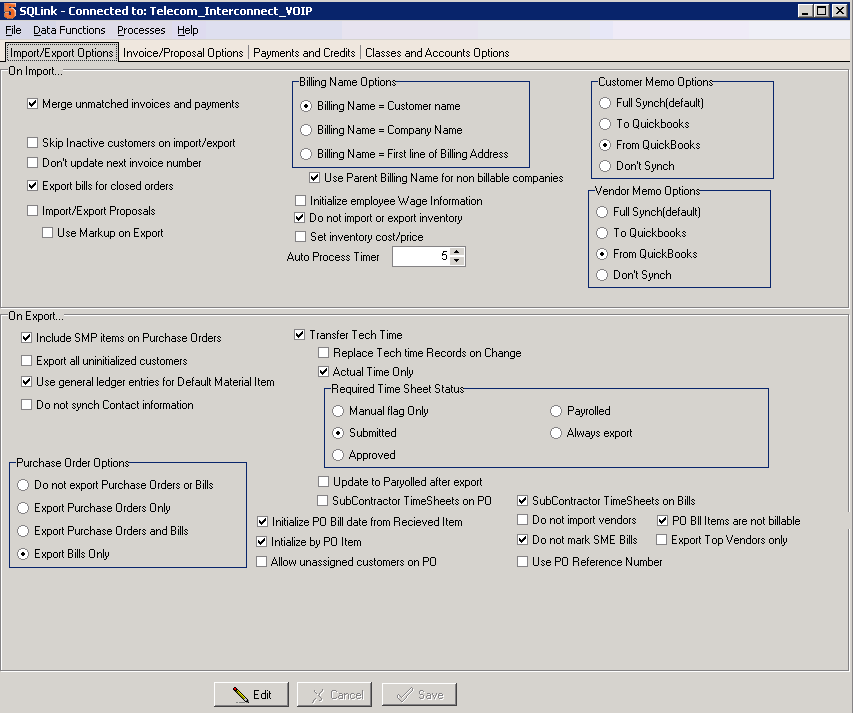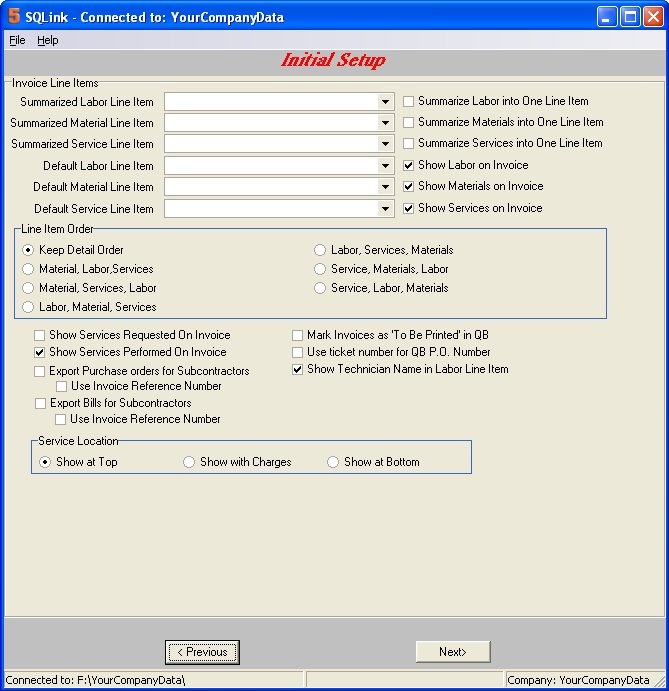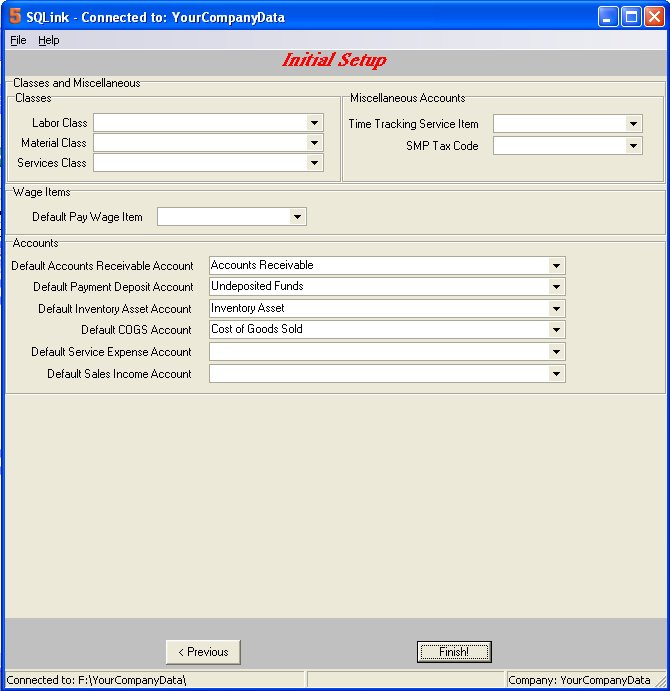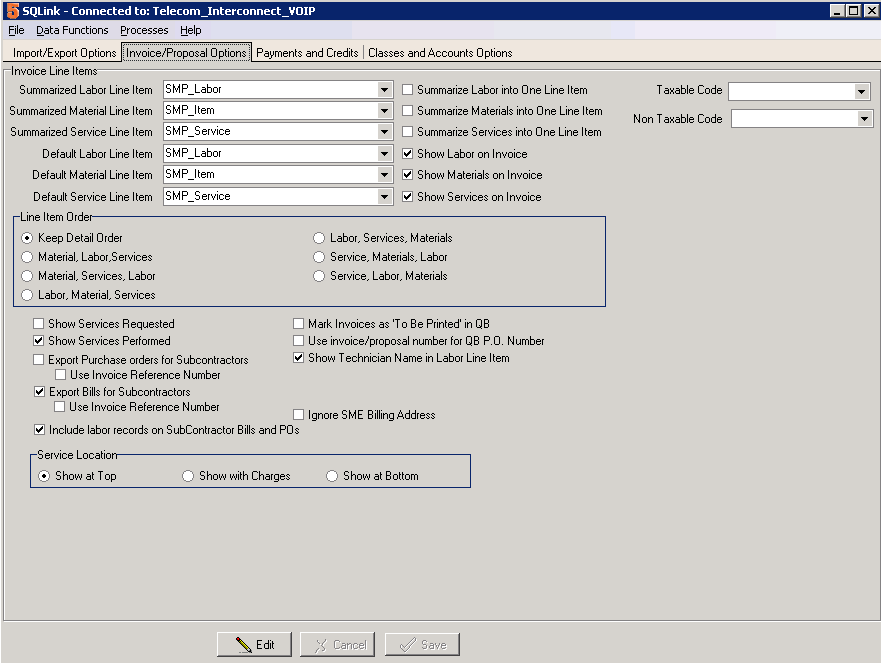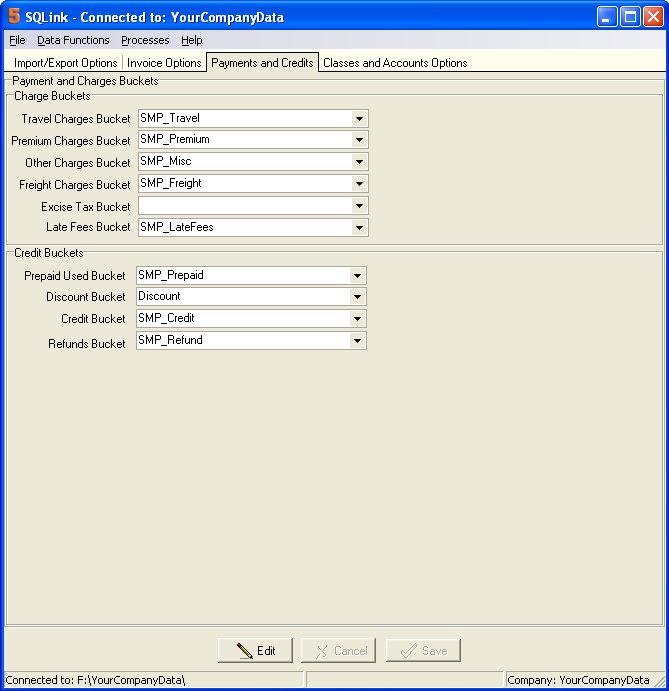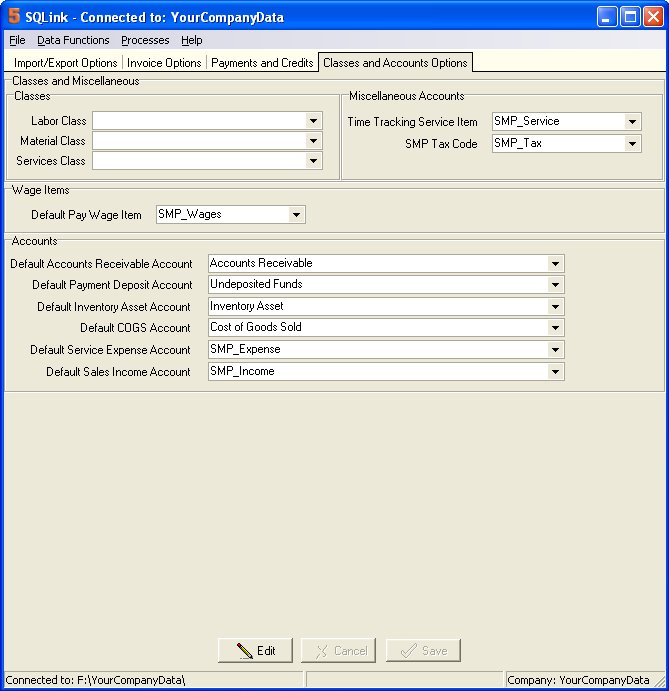Initial Setup for SQLink
'SQLink Installation and Setup'
SME to QuickBooks Link Synchronization Tool
Definitions:
1) QB: QuickBooks® by Intuit®
2) SME: Service Management Professional (version 5) by High 5 Software™
3) SQLink: SME to QB synchronization program by High 5 Software™
SQLink is an add-on product to SME to synchronize SME and QB databases. For a complete list of the synchronization points review the Sync Points for SQLink page.
SME handles sales, customers, service orders, and inventory while QuickBooks handles the accounting, payroll, and banking integration. SME and QB together make a very powerful combination for managing your service business.
READ OVER THIS DOCUMENT CAREFULLY.
It is very critical that the interface between SME and QuickBooks is established properly for your business. The SQLink Wizard will fill in the necessary values as defaults. It is recommended that these values remain in place unless they conflict with your business operations.
Your initial synchronization must take place on the computer hosting the SME database! Please plan for a time when you can complete the process without interruption from other system demands. If on a networked system install the programs on your server. If you do not have a server, designate a system to host the database, and install the programs on that system.
SME/SQLink, and QuickBooks must already be installed on the computer where you will run SQLink. If either of these programs is NOT installed, you must install the missing programs. SQLink installs with SME in the SME program folder.
Important: QuickBooks must be updated before performing the initial sync! This may mean that you will have to perform the QuickBooks update on all other computers where QuickBooks has been installed.
SME and QuickBooks: Must have company data filled in. If both SME and QuickBooks are installed and the QuickBooks company file has data, please proceed with these instructions.
Suggestion: It is recommended to start with copies, (sandbox copies) of SME and QuickBooks, rather than your live data until you get the synchronization settings established the way you need to match your business processes. Once all settings are correct and information is passing between the applications to your satisfaction you can setup a live sync with a fresh empty SME database.
Advised: To avoid possible data issues it is advised you run the QuickBooks Verify and Backup utility prior to setting up SQLink and SME.
There are two types of initial synchronizations:
- To an SME install with no prior data importing the QuickBooks data. (Referred to as an initial sync.)
- To an SME installation that has been used for running your business and a QuickBooks file that has also been used to run your business without synchronization. (An in place sync.)
If your installation falls under number 2 please contact High5Software prior to performing the initial sync as care must be taken to clean up data that may cause issues when syncing.
Initial sync to a newly installed SME application: SQLink will install with SME in the SME program folder.
- SQLink will locate your open QuickBooks file.
- QuickBooks will open the Access Confirmation dialogue shown below.
- Note: on some versions of QuickBooks this will happen again at a later stage in the setup process.
- You will see the following screen in QuickBooks.
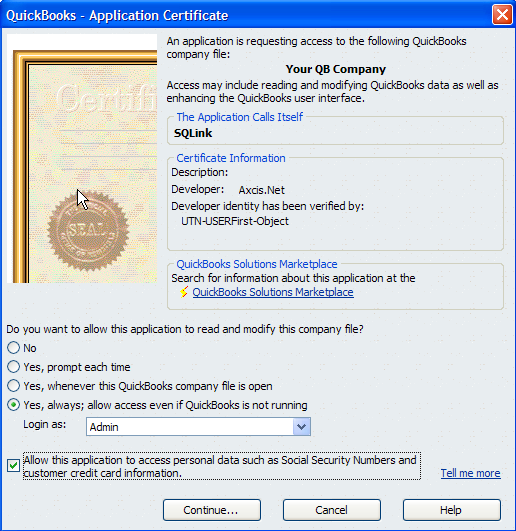
- Click on ‘Yes’, always allow access even if QuickBooks is not running.
- Login as “Admin” (Note: Admin is the level required for SQLink to accesses QB. It is not the level users of SQLink access QB.)
- Check the “Allow this application to access personal data…” This will allow transfer of technician information to QuickBooks.
- Your settings should be as follows:

10. Click “Continue”.
11.You may get a certification warning. Click 'Yes' on this screen.
12.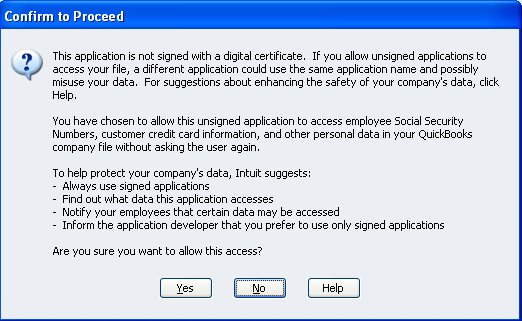
13.You will see the following QuickBooks screen:
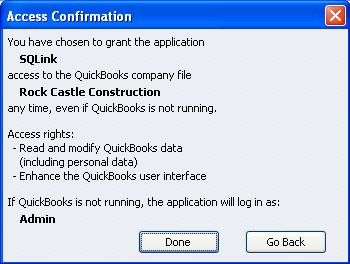
14.Click “Done”.
15.SQLink will now be listed in the Integrated Applications List in QuicBooks.
Set Up For Initial QuickBooks Company
- SQLink will open with the Set up for Initial Company window.
3.The following set up options require attention:
4.Database name (Select Existing) field. Copy the database name from this field.
5.Company Name (Select Existing or Enter New) field. Paste the database name into this field.
6.QuickBooks Company File Location: Click the ellipse in the QuickBooks Company File location and browse to the location of your company file.
7.Note: You can obtain the QuickBooks Company file location by going to QuickBooks and pressing the ‘F2’ key. This will open the Product Information screen. The company file location is in the File Information block:
9.The paths must match exactly!
10.Note: On Vista and Newer operating systems you will be required to close QuickBooks before you can set the path. This is also true of Windows Server 2008.
11.Enter your Area Code
12.Select your Country. (Default is US.)
13.Enter your email address if you want error logs emailed
14.Select your QuickBooks year
15.Click ‘Ok’.
16.Note: On some operating systems you may need to repeat the above steps 2 times before QuickBooks will register the company file path.
SQLink - Initial Setup
Refer to the following steps to set SQLink options and complete the initial sync. Options and settings for the Initial Setup can also be configured after the initial sync. For detailed information on the implications of specific settings refer to the appropriate Wiki page.
On Import: On import settings cover SQLink functionality when importing information from QuickBooks for Invoices and Payments, Inactive Customers, Next Invoice Number, and Billing Name Options.
- Merge unmatched invoices and payments: Check this box to match QuickBooks invoices and payments. Leaving it unchecked will not import payment information from QuickBooks. (The usual setting is checked)
- Skip inactive customers on import/export: Checking this box will keep SQLink from importing or exporting inactive customers. Since both SME and QuickBooks are programmed to work with inactive customers it is recommended that you do not check this option. (Usual status is Unchecked)
- Billing Name Options: Default setting is Billing Name = Customer Name. For more info on this topic review the SQLink - Customers wiki page
- On Export: On Export settings cover Tech Time and Purchase Order options.
- Include SMP items on Purchase Order: This option will pass the default SQLink item for that actual item used in QuickBooks if the item does not exist in QuickBooks. (Usual setting is Checked)
- Purchase Order Options.
- Do Not Export Purchase Orders or Bills
- Export Purchase Orders Only – Bills will not export
- Export Purchase Orders & Bills
- Export Bills Only: Since Purchase Orders require further action to tie them to Bills in QuickBooks the Bill is the method of inventory adjustment in QuickBooks. (This is the recommended setting.)
- Make your selections based on the above information and click ‘Next’.
- SQLink will import the following QuickBooks items:
- Pay Methods
- Sales Tax Codes
- Terms
- Classes
- Sales Reps
- Tax Code Groups
- Accounts
- Pay Items
- Discount Items
- Wage Items
- Employee List
- Vendor List
- Inventory List
- Non-Inventory List
- Service List
- Other Charges List
- Inventory Groups
Initial Setup - Invoice Options: Options on this screen determine how invoices export from SME to QuickBooks. These options can be changed after the initial import.
- Invoice Line Items – determines what shows on the invoice for Labor, Material, and Services. These items are ‘default’ items and will be passed on the invoice should an item that is only in SME, and not in QuickBooks, be used on an invoice. (Default settings are to Show Labor, Materials, and Service.)
- Line Item Order: Determines the order of information as it is exported to QuickBooks. (Usual setting is to keep Detail Order.)
- Other Options:
- Show Services Requested. (Usual option is to Not show Services Requested.)
- Show Services Preformed On Invoice. Usual option is To show Services Preformed.)
- Export Purchase Orders for Subcontractors:
- Use Invoice Reference Number:
- Export Bills for Subcontractors
- Use Invoice Reference Number
- Mark Invoice as ‘To Be Printed’ in QuickBooks
- Use ticket number for QuickBooks P.O. Number
- Show Technician Name in Labor Line Item
- Service Location:
- Show at Top
- Show with Charges
- Show at Bottom
- Service Location:
- Make your selections and press ‘Next’
Initial Setup - Payment and Charge Buckets: Options on this screen determine which accounts SQLink will use for the following items. You do not need to select any settings at this time as these will be filled in by the SQLink initial setup wizard.
- Charge Buckets
- Travel Charges Bucket
- Premium Charges Bucket
- Other Charges Bucket
- Freight Charges Bucket
- Excise Charges Bucket
- Late Fees Bucket
- Credit Buckets
- Prepaid Used Bucket
- Discount Bucket
- Credit Bucket
- Refunds Bucket
- Click ‘Next’.
Initial Setup - Classes & Miscellaneous: Options on this screen determine how default classes, time tracking accounts, wage item, and other accounts will pass information. This information will be filled in automatically when the wizard completes the import process.
- Classes
- Labor Class
- Material Class
- Services Class
- Miscellaneous Accounts
- Time Tracking Service Item
- SMP Tax Code
- Wage Items
- Default Pay Wage Item
- Accounts
- Default Payment Receivable Account
- Default Payment Deposit Account
- Default Inventory Asset Account
- Default COGS Account
- Default Service Expense Account
- Default Sales Income Account
- Click ‘Finish’: SQLink will create SQLink default items named SMP_<Item name> in QuickBooks and then complete the importing process.
NOTE: The time required to process an initial import will depend on 2 factors:
1. Number of items in QuickBooks – Customer List, Item List, & Invoice/Payment list. Company files with a lot of information can take hours to process the initial import. Be prepared for this eventuality when starting the syncing process. 2. System resources available to QuickBooks during the sync. If you are running the sync on a system with marginal memory or one that is short on disk space there will be a significant impact on the time required to process the initial sync.
SQLink will complete the following tasks:
- Creating Default Values
- Retrieving Tax Codes
- Creating SMP_tax item
- Retrieving QuickBooks Customers
- Retrieving Invoices and payments
- When the import is complete SQLink will return to the initial Setup tab; Import/Export Options.
SQLink Setup Screens Post Import:
Import/Export Options:
Payments and Credits:
Classes and Accounts Options:
The Initial Sync is complete. Close all programs, SME, SQLink, and QuickBooks, and reopen them to process the first regular sync.
Note: This sync can also take a considerable length of time since status flags are initialized on all imported items. QuickBooks is not required to be in ‘Single User’/Admin mode for this sync.
Refer to the following Wiki page for information on processing a regular sync.
http://high5software.com/high5bitweaver/wiki/index.php?page=SQLink+Full+Sync+
